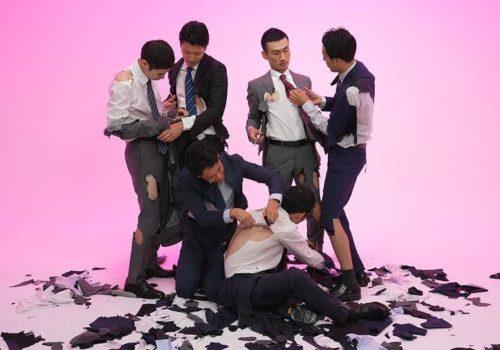Among the myriad exhibitions in the Yaesu district, the T3 Photo Festival Tokyo offers a view on the construction of masculinity through the lens of the image.
Curated by Mika Kobayashi, the exhibition “Where did this ‘masculinity’ come from?” echoes the fiftieth anniversary of the landmark exhibition opened at MoMA in 1974, which sought to gather and shed light on the vibrant photographic creation in Japan. While that exhibition allowed the American public to grasp the work of Moriyama or Hosoe, it also consisted of 13 artists — 13 men — reflecting a vision of photography, art history, and society that was deeply disparate.
With a film by Kai Keijiro and another by Takata Fuyuhiko, curator Mika Kobayashi didn’t aim to correct a historical error but rather to emphasize the normative masculine values structuring her society through images, advertising, public information, education, and morality.
Clothed in Sunny Finery by Kai Keijiro reveals almost-naked bodies, clad in a white shroud (fundōshi), all male, engaged in collective jubilation at the borderline between communion, ecstasy, and battle. These frenetic rituals, bordering on chaos, bring together dozens of men competing in teams or individually, in the cold and darkness of winter. Without being overtly critical of this masculine ordeal, the film captures a virile impulse, a muscular need for proof, trial, and adrenaline, which induces a form of purity and transcendence.
Kai Keijiro’s film is juxtaposed with the more ironic one by Fuyuhiko Takata, titled Cut Suits. Four men, tangled together, tear their suits to shreds in sensual, precise gestures, enjoying the baring of their bodies, turning their business suits into rags and tatters. The symbolism is particularly strong in a city where office attire profoundly defines gender norms for both men and women. The juxtaposition of the two films also highlights how the male gaze constructs masculinity, molded into a rigid framework of appearances.
The presentation of these two films is followed by an in-depth exploration of masculine imagery, which is arguably the highlight of the exhibition. Masculinity, from a visual standpoint, is examined from every angle: beer and its advertising, men in the prime of life promised a bright future, men depicted as industrialized robots, or the shining doctor confident in his righteousness. In the main showcase, the image of the powerful samurai is also undermined, rendered laughable or even touching by the juxtaposition of his heroic, sometimes extremely sexualized, poses.
The exhibition is crafted with great subtlety and would almost be humorous if it didn’t reveal the mechanisms of virile and sexualized representations and behaviors, which structure Japanese society and mirror our own in the West.
More information
















